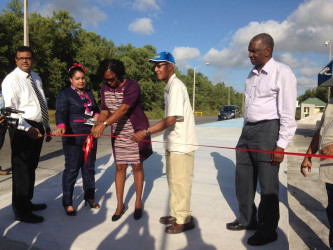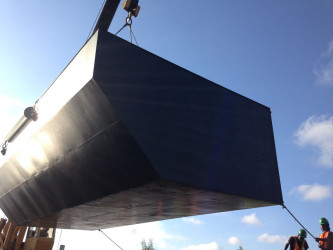The Berbice Bridge Company Incorporated (BBCI) yesterday commissioned a $177M jack-up barge which is designed to facilitate the changing of pontoons that are keeping the bridge afloat.

The jack-up barge with auxiliary units was described as a workable solution for the removal and replacement of the majority of the pontoons from under the bridge. According to BBCI reps, the current pontoons have been keeping the bridge afloat for eight years and it is time for them to be changed as a part of their maintenance schedule.
The bridge company is set to start replacing the pontoons sometime between November 2015 and January 2016. At the simple commissioning ceremony held at the BBCI headquarters in Berbice, Jerry Gouveia, contractor of Industrial Fabrication Incorporated delivered a detailed presentation on how the barge is intended to be used.
He explained that a team of six persons including himself and engineer Egbert Carter, who is also the Chairman of the BBCI, looked at several different models for the barge and chose a seven-unit unifloat design. The unifloat barge with auxiliary units is able to uphold two hundred tonnes of weight with the support from the other pontoons.
Gouveia related that the jack-up barge would be assembled in the river after which it would be floated under a span, adjacent to the pontoon that needs to be removed. He said that four jacks will be activated to lift the spans at a calculated height based on the tide. Gouveia explained further that when the span is jacked up, they would move the pontoon to a dry area where it would be inspected and serviced. In the meantime, another pontoon would be put in place to allow for the efficient functioning of the bridge.

According to the bridge company, in order to undertake the replacement and removal of pontoons for servicing, they have acquired two spare pontoons built by E.C. Vieira Investment Inc at the cost of $137M.
The company noted that the maintenance of pontoons includes the removal of the pontoons, internal and external examinations, cleaning, water blasting, and sand blasting, before applying at least two coats of special marine paint. It also indicated that the revised design caters for more flexibility and redundancy in the system along with fewer risks. The barge was designed and built by Guyanese in Guyana by Industrial Fabrication Inc. However, some critical components had to be manufactured overseas.
In brief remarks, Minister within the Ministry of Public Infrastructure Annette Ferguson said the commissioning signifies commitment to service and the company’s willingness to play its part in ensuring that there is smooth flow of traffic and limited interruption of service to commuters.
She noted further that the BBCI’s dedication is testimony of a good corporate citizen willing to work on operational efficiency.
Ferguson also commended the engineers from Guyana and overseas for a job well done. “Persons who contributed to the design and establishment of the jack-up barge ought to be commended. Their hard work and dedication is one we should hold dearly,” the minister asserted.
Meantime, the BBCI said that after the completion of the bridge, the builders – the consortium of Bosch Rexroth and Mabey & Johnson, failed to supply the company with a comprehensive operation and maintenance manual in particular for the removal and replacement of the pontoons supporting the superstructure of the bridge.
The company noted that the removal and replacement of the pontoons is the most important aspect of the operation and maintenance and there should have been a methodology to do that especially for the high span and acceptor and retractor spans. Further, it was disclosed that when the company contacted the contractors, it was indicated to them that provision of a manual was not a part of their contract and they were therefore not obliged to provide any methodology for changing the pontoons.
As a result, the bridge company sought quotations from international companies and received one which quoted 120,000 pounds from the United Kingdom and another from the United States which put the cost at US$25M.
Meanwhile, the BBCI also commissioned a 100 tonnes weight scale on the eastern side of the bridge. This, the company said, would be more effective for commuters who are travelling from the East Berbice as they would no longer have to cross the bridge then wait for weighing.








